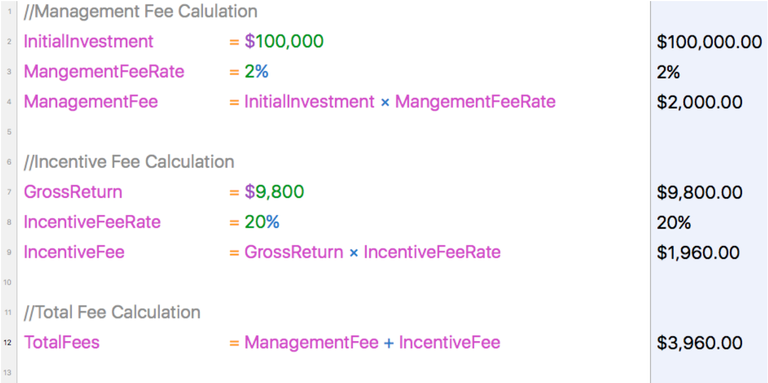Nobody works for free – least of all hedge fund managers.
So, despite their investments in bitcoin, ether and other emerging digital assets, there are certainly no major leaps in how cryptocurrency hedge funds appear to be calculating their costs.
All crypto hedge fund managers get paid in the fees they charge to investors – and, just like in traditional markets, those fees aren't always easy to understand. Calculating the costs and possible return on your investment can prove challenging, given that fee structures are often described in ways that marry the worst aspects of legalese with the wonky accounting of tax documentation.
To shine a light on how these costs work, CoinDesk obtained a copy of a fee structure for a cryptocurrency fund. The following example is loosely based on a product now actively available in the market, but greatly simplified to make its terms and conditions easier to parse.
CoinDesk assumed a $100,000 investment in a fund with a vanilla "two and 20" fee structure that earns a 10 percent gross return.
While the example below is just that – one example – it can still be a helpful metric to aid you in your evaluations. After all, while a cryptocurrency hedge fund may be appealing – it should also be compared to the pros and cons of your own active management.

Management fee: $2,000
The first point to understand when looking at a fund is the management fee, which is what you pay upfront as soon as you invest in the fund.
The typical management fee is 2 percent on every dollar you invest. As an example, let's say you've found a fund with a solid strategy, and it has a minimum investment of $100,000. This means that on your $100,000 investment, you would get charged $2,000, meaning you're only "putting to work" $98,000 in the investment.
Right off the bat, that's money that won't be going directly into the market, and in cryptocurrency, where there have been historical benefits to holding, that might be something to consider.
Still, that might not necessarily be a deterrent. Let's say at the end of the year, the fund generates a 10 percent return, as in this example, you could end up with a potentially attractive profit.
Depending on what you were expecting, you may be thrilled or you may be disappointed – but, either way, you're probably not done paying fees yet.
Incentive fees: $1,960
In the most basic analyses, there are two kinds of fees that hedge funds charge their investors: management fees, like the 2 percent discussed earlier, and "incentive fees" that are applied to profits.
In a typical, vanilla fund scenario, investors pay around 20 percent fees on their returns. These fees are usually called incentive fees because they seek to align investor returns with the compensation of the fund managers.
The percentages charged on incentive fees are typically far higher than management fees, which makes sense, because the fund's managers or general partners are being rewarded for their product's performance. So, the greater the return that fund managers make for their investors the greater the fees they earn for themselves.
Let's continue to assume that the fund you invested in generated a 10 percent gross return. Since you earned 10 percent profit on your investment after management fees, the gross return, before the incentive fees were charged, would be $9,800.
A 20 percent fee charged against your gross return means another $1,960 in fees get assessed.
Total cost: $3,960 and return
So, adding it all up, you would pay a total of $3,960 in fees on your investment in the fund.
Let's take a look at the investment from a different angle — the rate of return you received on your investment.

After the management fee and incentive fees get charged, investors would receive a $7,840 net return on their investment, or a 7.84 percent rate of return for the year.
Whether or not that fits the bill with your expectations, is up to you as the investor. As mentioned above, given the extreme volatility of the cryptocurrency markets, there can be upside or downside in putting your money to work directly on available exchanges.
Still, if you're looking for exposure to a very volatile market, and you're not interested in doing the legwork required to actively manage your own portfolio, the above example should give you a better sense of the potential costs – and possible returns.
Taken from coindesk: https://www.coindesk.com/crypto-hedge-fund-costs-invest-100k-and-heres-how-much-youd-pay/
Hi! I am a robot. I just upvoted you! I found similar content that readers might be interested in:
http://www.universalcointrade.com/crypto-hedge-fund-costs-invest-100k-and-heres-how-much-youd-pay/
Congratulations @steveoconnor! You have completed some achievement on Steemit and have been rewarded with new badge(s) :
Click on any badge to view your own Board of Honor on SteemitBoard.
For more information about SteemitBoard, click here
If you no longer want to receive notifications, reply to this comment with the word
STOP